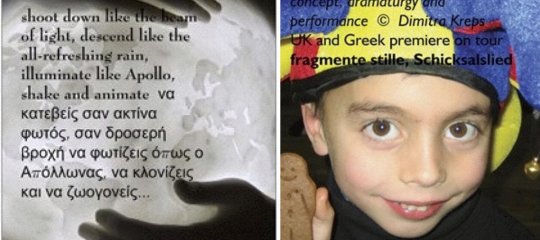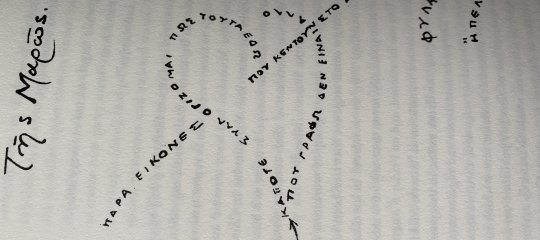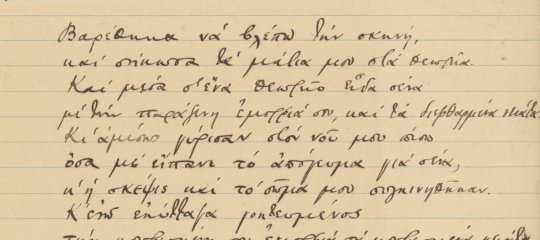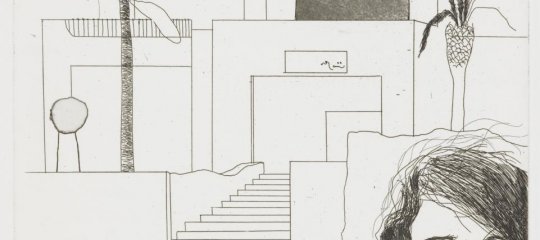Ελληνικά στο Αμμάν
Vassilis writes, "Ίδρυση του Τομέα, λειτουργία, επίπεδα ελληνομάθειας κι άλλα στο Πανεπιστήμιο της Ιορδανίας
Βασίλης Οικονομίδης"
10 Μαρτίου 2005
Καθυστέρησα κάπως να ενημερώσω σχετικά με τη λειτουργία και τα χαρακτηριστικά του Τομέα Ελληνικής Γλώσσας στο Τμήμα Μοντέρνων Γλωσσών του Πανεπιστημίου της Ιορδανίας. Όχι από αμέλεια, μα από δυσκολίες "διαδικτυακού" τύπου...
Ο Τομέας Ελληνικής Γλώσσας λειτουργεί στο Πανεπιστήμιο της Ιορδανίας από το 1998 στο πλαίσιο του Τμήματος Μοντέρνων Γλωσσών.
Ο Τομέας μας προσφέρει μαθήματα νέας ελληνικής γλώσσας και πολιτισμού σε δύο επίπεδα αρχαρίων (δύο εξάμηνα), τα οποία μπορούν να πιστωθούν και να παρακολουθήσουν φοιτητές πολλών Σχολών και Τμημάτων, ως μαθήματα ελεύθερης επιλογής. Επιπλέον οι φοιτητές της Φιλοσοφικής σχολής έχουν τη δυνατότητα να παρακολουθήσουν και το μάθημα "Ελληνική Γλώσσα, 3" (ενδιάμεσο επίπεδο) ως υποχρεωτικό κατ'επιλογή αντικείμενο. Ανάλογο τίτλο είχε προσφέρει ο Τομέας μας στο παρελθόν, με πρωτοβουλία του εξαιρετικού συναδέλφου Δημήτρη Καραδήμα, καλή του ώρα... Πράγματι, κατά το χειμερινό εξάμηνο του τρέχοντος ακαδημαϊκού έτους το συγκεκριμένο επίπεδο άρχισε να λειτουργεί κανονικά με μικρό αριθμό φοιτητών αλλά με επιτυχία κι ενθουσιασμό από τη μεριά των φοιτητών μου. Εκτός από τα παραπάνω, σε συνεργασία με το Τμήμα Αρχαιολογίας, προσφέρεται συνήθως για ένα εξάμηνο ανά ακαδ. έτος και εισαγωγικό μάθημα στα Αρχαία Ελληνικά. Για το τελευταίο, η εξάσκηση γίνεται με εγχώρια κυρίως δείγματα επιγραφικής, έτσι ώστε οι μελλοντικοί αρχαιολόγοι να είναι σε θέση να αναγνωρίζουν και να αξιοποιούν τις πληροφορίες από το πλούσιο υλικό που κρύβει η γη της Ιορδανίας.
Για τα Νέα Ελληνικά, οι φοιτητές μας ανέρχονται περίπου στους 60 στα διάφορα επίπεδα ενώ για τα Αρχαία Ελληνικά περίπου στους 15. Για τα Νέα, χρησιμοποιούμε συνήθως ως εγχειρίδιο το έργο των Δημητρά και Παπαχειμώνα, Ελληνικά Τώρα 1+1, (επίπεδα 1 και 2) και για το τρίτο επίπεδο το πόνημα των ιδίων, Ελληνικά Τώρα 2+2. Πειραματίστηκα και με άλλο υλικό, κυρίως της ομάδας του Πανεπιστημίου Κρήτης και συχνά χρησιμοποιώ ασκήσεις από τα εγχειρίδιά τους (Ελληνικά με την Παρέα μου, κ.λπ.). Επίσης για τις διδακτικές ανάγκες, αξιοποιώ και το υλικό του Κέντρου Διαπολιτισμικής Αγωγής του Πανεπιστημίου Αθηνών (Υπόθεση Γλώσσα, κ.λπ.). Για το μέρος της ιστορίας και της κουλτούρας, βρήκα χρήσιμο των Koliopoulos - Veremis, Greece- The Modern Sequel (from 1831 to the Present), αλλά χρησιμοποιούμε επίσης υλικό από δικτυακούς τόπους, άλλοτε στα ελληνικά κι άλλοτε στα αγγλικά. Για το δεύτερο και τρίτο επίπεδο, φροντίζω ώστε η μία από τις τρεις διδακτικές ώρες να αφιερώνονται σε εξοικείωση των φοιτητών με γνωρίσματα και δείγματα της νεότερης και σύγχρονης λογοτεχνικής μας παραγωγής. Τα σχετικά απλούστερα κείμενα από γλωσσική άποψη (παραδείγματα που φέρνω πρόχειρα στο νου, Σεφέρης, Σαχτούρης, Ρίτσος, Ιωάννου, Δημουλά) προσεγγίζονται στο πρωτότυπο και γίνονται καλές αφορμές για εμπέδωση κι εμπλουτισμό του λεξιλογίου. Άλλα, δυσκολότερα ή εκτενέστερα, προσεγγίζονται από μετάφραση (Friar, Keeley, O'Grady). Τελικά, διαπίστωσα πως η ποίηση, η λογοτεχνία εν γένει, λειτουργούν θαυμάσια και κρατούν κλειδιά ψυχικής εγγύτητας για τους Άραβες. Ο Καβάφης συναρπάζει... Όλα τα μαθήματα διδάσκονται από τον γράφοντα.
Η αραβική γλώσσα ως μητρική, συνήθως στέκεται βοηθός στο γλωσσολογικό επίπεδο. Τα φωνήματα είναι ήδη πλούσια και δεν απαιτούν κόπο για την προσαρμογή στη νέα γλώσσα. Επίσης, το ζήτημα του γραμματικού γένους είναι θεμελιώδες και για την αραβική, μολονότι πρόκειται για διπολικό σχήμα (αρσενικό-θηλυκό). Συχνά, για τους χρωματισμούς του νοήματος, η σχέση των δυο αυτών γλωσσών φανερώνει εντυπωσιακές ομοιότητες κι απλοποιεί τη διαδικασία της κατανόησης. Θα μπορούσε κανείς να επανέλθει στο ζήτημα και να το περιγράψει με παραδείγματα.
Εκτιμώ από τις συναφείς συζητήσεις κι ερωτήσεις μου ότι το κίνητρο των φοιτητών για την επιλογή των μαθημάτων Ελληνικής είναι η εκτίμηση που τρέφουν για τον ελληνικό πολιτισμό- γνωρίζουν κυρίως τον αρχαίο- και η φιλία που αισθάνονται για τη σύγχρονη Ελλάδα, μια οικεία Δύση, ή μια διαφοροποιημένη Ανατολή. Αρκετοί προέρχονται από οικογένειες που κάποιο μέλος τους σπούδασε στην Ελλάδα κατά τις δεκαετίες 1970 και 1980 και παραδέχονται ότι οι πληροφορίες που είχαν, λειτούργησαν ως ώθηση. Υπάρχει επίσης αριθμός παιδιών που προέρχονται από μικτούς γάμους, δεύτερης και τρίτης γενιας, που ενδιαφέρονται να ενισχύσουν την επαφή τους με εκείνο το κομμάτι της ταυτότητάς τους. Σε κάποιες περιπτώσεις, η επαφή τους είναι συναισθηματική μα σε γλωσσικό επίπεδο ξεκινούν ως απόλυτα αρχάριοι ή ψευδοαρχάριοι.
Το Τμήμα Μοντέρνων Γλωσσών του Πανεπιστημίου της Ιορδανίας είναι ο καθρέφτης των προθέσεων της Ιορδανίας για ανοίγματα προς άλλους πολιτισμούς. Φιλοξενεί, πέρα από τις βασικές γλώσσες ειδίκευσης (Γερμανικά, Ιταλικά, Ισπανικα, Αγγλικά, Γαλλικά), τομείς Ιαπωνικής, Κορεατικής, Περσικής, Τουρκικής, Ρωσσικής, Κινεζικής και βεβαίως Ελληνικής. Αναφέρω ότι, μέχρι τώρα, μόνον για τα Ελληνικά ο κοσμήτορας της Φιλοσοφικής Σχολής εισηγήθηκε τη λειτουργία τρίτου επιπέδου.
Αρκούν, ελπίζω, αυτά για μια πρώτη γνωριμία με τη διδασκαλία των Ελληνικών στην ανώτατη εκπαίδευση της Ιορδανίας.
Πολλά χαιρετίσματα από το βροχερό Αμμάν,
Βασίλης Οικονομίδης
- Εισέλθετε στο σύστημα για να υποβάλετε σχόλια










